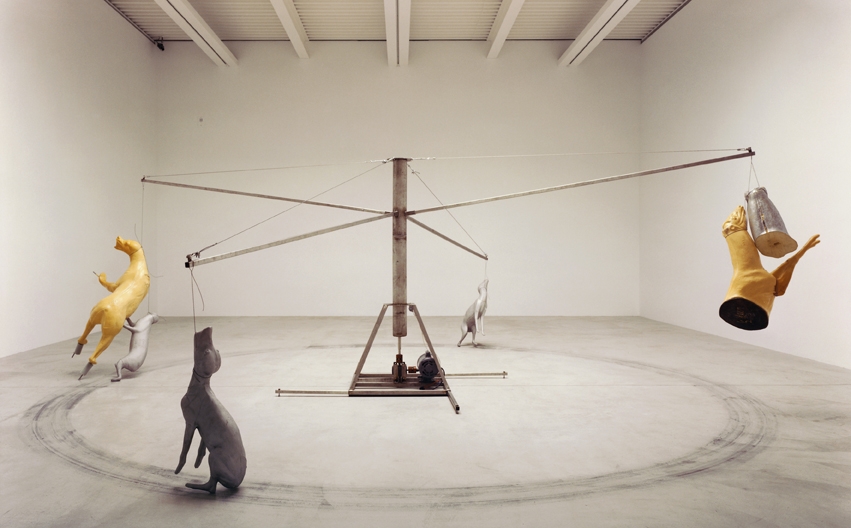If you are Bruce Nauman, and you’ve been asked to fill the Fondation Cartier with your artworks, which would you choose? You’ve been producing art for 50 years, most of it provocative, some of it darkly humorous and disturbing, quite a bit truly excruciating. “Art that knocks you down,” you’ve called it, “like getting hit in the face with baseball bat.” There is, however, not a lot of bat in your newer work, most of which focuses, very simply, on your hands: how they respond to instructions, what they do and make, and the sausage-esque parallax effect produced when you point your forefingers at each other and stare at them for a really, really long time. It is neither aggressive nor transgressive. If I had to say something about it (which I am loathe to do – contemporary art criticism rarely sounds more cack-handed than when analysing your work), I’d call it calmly contemplative. There’s no ‘pay attention mother fuckers’ (Pay Attention, 1973) type stuff. No antiart. No politics. No sex. No scary clowns. No torture. No complicity, no guilt.
I’m not saying that’s bad, I’m just saying.
Now, you haven’t had a solo show in France since 1998, so people will want to see a range of work, but there’s not much exhibition space at the Fondation – windowless basement, glassed-in main floor with high glass walls, and garden – so only a small selection will fit. How about one work from each decade? A sculpted or photographed pun, or a bat-in-the-face audio work from the 1960s. A videotaped studio performance, neon sign, lithograph or claustrophobic corridor installation from the 70s. An angry, politicised sculpture or loud harrowing video from the 80s. Maybe a dismembered taxidermy sculpture from the 90s. And one of the gentler hand-based works – drawing, video, sound piece, bronze sculpture – from this century.
No? Then let’s do looping and/or spinning works. Start with the text-on-paper For Children / For Beginners (2010), with its scrawled-out loops like this: ‘Teaching children / Children teaching’ – which we first saw at Sperone Westwater in New York, a year after you won the Golden Lion at the Venice Biennale. This links to your hand instruction pieces, specifically those fuelled by Bartók’s For Children compositions for piano, written for children-size hands. Combine this paper work, on a wall on one side of the main floor, with the sound piece For Children / Pour les enfants (2015) – based on the 2010 edition of this work, in which your voice repeats the words “for children”, to which, now, the repeated French phrase “pour les enfants” is added. In the garden, add a tuneless ‘musical’ echo of this, the sound piece For Beginners (Instructed Piano) (2010), in which the thumb and finger positions (of the child-size hand) are transposed into struck keys near middle C on the piano.
Now, place the giant Pencil Lift / Mr Rogers (2013) video installation of your hands, shot in your studio, in which you converse with the cameraman while trying to balance a pencil nub, sharpened on both ends to look like a sausageesque parallax illusion, between two sharpened pencils – while your cat, Mr Rogers, wanders past in the background. (People can’t seem to get enough cat videos, and Mr Rogers is a splendid cat.) Downstairs, Carousel (Stainless steel version) (1988), one of the readymade taxidermy-form pieces, this one spinning, scraping the floor. Opposite, the famous Anthro / Socio (Rinde Facing Camera) (1991) – six monitors, three screens, one bald head – singsonging three series of words: “Feed me / Eat me / Anthropology”, “Help me / Hurt me / Sociology” and “Feed me / Help me / Eat me / Hurt me”. In between, Untitled (1970– 2009), a protocol work staged as a performance in 1970, restaged in 2009 as a film – unassisted by you in both cases, but based on your written instructions. Two dancers seen from above lie on a sort of square dial on the floor, feet extended, hands over head and entwined at the centre, and spin, or roll, like the hands of a clock. The camera also spins from time to time, at the same speed as the dancers. It’s all very mesmerising. A profound meditation on the passing of time.
That’ll do it.
This article was first published in the May 2015 issue.
